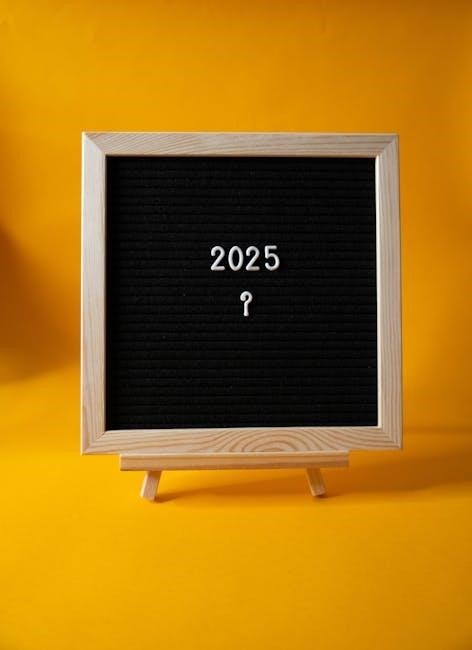Introducing problem-solving skills in the first grade helps students develop critical thinking through playful activities and real-life examples, preparing them for academic success.
1.1. Understanding the Importance of Problem Solving Skills
Problem-solving skills are essential for 1st graders as they enhance cognitive development and prepare students for future academic challenges. These skills help children think critically, make logical connections, and approach tasks confidently. By solving simple arithmetic and word problems, students develop independence and analytical thinking. Problem-solving also fosters creativity, encouraging children to explore multiple solutions. These foundational skills are vital for real-life applications, enabling students to navigate everyday situations effectively. Introducing problem-solving in early education ensures a strong academic foundation and lifelong learning abilities.
1.2. Basic Concepts and Strategies for Young Learners
Teaching problem-solving to young learners involves using simple, engaging methods. Step-by-step approaches help students break down problems into manageable parts. Visual aids like counting blocks or number lines enhance understanding. Encouraging children to identify the problem, gather information, and test solutions builds confidence. Using real-life scenarios, such as sharing toys or measuring lengths, makes learning relatable. Introducing basic arithmetic operations through play fosters a strong foundation. These strategies ensure that 1st graders develop essential skills while maintaining a love for learning. By keeping activities interactive and fun, educators create an environment where problem-solving becomes an enjoyable and natural process for young learners.

Methods for Teaching Problem Solving
Effective teaching methods involve step-by-step approaches, visual aids, and hands-on activities. Encouraging students to ask questions and explore solutions fosters creativity and critical thinking, making learning engaging and effective.

2.1. Step-by-Step Approach to Solving Problems
A step-by-step approach helps young learners break down problems into manageable parts. Teachers guide students to read the problem carefully, identify key details, and choose the right operation. Visual aids like number lines or counters support understanding. Practicing with real-life scenarios, such as sharing toys or counting objects, makes learning relatable. This method builds confidence and ensures a solid foundation in problem-solving skills for first graders. Regular exercises and feedback help reinforce these strategies, making them a valuable tool in early math education. This structured approach is particularly effective for developing critical thinking in young children.
2.2. Encouraging Critical Thinking and Creativity
Encouraging critical thinking and creativity in problem-solving helps first graders develop innovative solutions. Teachers use open-ended questions and group activities to stimulate imagination. For example, asking students to design a solution for sharing toys or creating a story to explain math problems fosters creativity. Play-based learning, such as building structures with blocks, also enhances problem-solving skills. Providing opportunities for brainstorming and celebrating diverse ideas nurtures a growth mindset. These strategies help students approach challenges with confidence and develop a deeper understanding of math concepts. By fostering creativity, educators prepare young learners to tackle complex problems in the future.

Types of Problems for 1st Graders
First graders engage in simple addition, subtraction, and word problems involving everyday situations. Basic equations and real-life scenarios help build foundational problem-solving skills effectively.
3.1. Simple Addition and Subtraction Problems
Simple addition and subtraction problems introduce foundational math skills for 1st graders. These problems often involve counting objects, combining sets, or finding differences. For example, scenarios like “Lancelot jumped into 10 puddles on his way to school and 6 on his way back” encourage students to add or subtract small numbers. Word problems, such as “Zack has 15 toy cars and finds 7 more,” help learners connect math to real-life situations. Printable worksheets and PDF materials provide structured practice, making these concepts engaging and accessible for young students. These exercises build a strong foundation for more complex problem-solving in the future.
3.2. Word Problems Involving Everyday Situations

Word problems involving everyday situations help 1st graders connect math to real life. Examples include scenarios like sharing toys, counting fruits, or measuring objects. For instance, “If Sarah has 5 apples and her friend gives her 3 more, how many apples does Sarah have now?” These problems encourage students to think critically and apply basic addition and subtraction skills. Printable worksheets and online tools offer interactive ways to practice these problems, making learning fun and engaging. By relating math to familiar situations, students build confidence and develop essential problem-solving abilities that are useful in daily life.
3.3. Basic Equation Solving
Introducing basic equation solving in 1st grade involves simple, visual methods to understand unknown values. For example, “If 3 blocks are under a cup and 2 more are added, how many blocks are there?” Students learn to represent these situations with equations like 3 + 2 = ?. Worksheets and online tools provide interactive exercises, such as solving for x in 5 + x = 8. These activities help students develop algebraic thinking and problem-solving skills through engaging, relatable scenarios. By mastering basic equations, students build a strong foundation for more complex math in later grades. This step-by-step approach fosters confidence and logical reasoning.

Example Problems and Solutions
Engage students with real-life scenarios like “Lancelot jumped into 10 puddles going to school and 6 coming back. How many puddles did he jump into?” Provide step-by-step solutions.
4.1. Real-Life Scenarios for Practice
Real-life scenarios make problem-solving engaging for 1st graders. For example, “Lancelot jumped into 10 puddles on his way to school and 6 on his way back. How many puddles did he jump into?” This problem uses simple addition, making it relatable and fun. Another example: “Sara has 12 crayons and her friend gives her 4 more. How many crayons does Sara have now?” These scenarios help students connect math to everyday life, fostering practical application of skills. Teachers can create similar problems involving toys, pets, or classroom items to encourage active learning and confidence in solving real-world problems. Regular practice enhances their problem-solving abilities.
4.2. Correcting Common Mistakes
Identifying and correcting mistakes is crucial in developing problem-solving skills. Common errors include miscalculations in addition or subtraction and misinterpreting the problem. For example, a student might add instead of subtract or reverse the numbers. Teachers should guide students to re-examine their work and explain their reasoning. Positive feedback encourages learning from errors. Providing clear examples and step-by-step solutions helps students understand where they went wrong. Encouraging peer discussion also fosters a supportive environment for correcting mistakes. By addressing these errors early, students build a stronger foundation in math and improve their problem-solving strategies over time. Regular practice and feedback are essential for progress.
Resources for Practice
Printable worksheets, PDF materials, and online tools provide engaging ways for first graders to practice problem-solving skills, ensuring consistent learning and fun.
5.1. Printable Worksheets and PDF Materials
Printable worksheets and PDF materials offer a variety of exercises tailored for first graders, focusing on addition, subtraction, and simple word problems. These resources often include visual aids like images and charts to make learning engaging. Many worksheets are designed with step-by-step solutions, helping students understand problem-solving methods. Teachers and parents can easily download these materials from educational websites, ensuring access to structured practice. Some PDFs also feature interactive elements, such as fill-in-the-blank sections, to enhance learning. These tools are ideal for homework or classroom activities, providing a hands-on approach to mastering basic math skills.
5.2. Online Tools and Interactive Exercises
Online tools and interactive exercises provide engaging ways for first graders to practice problem-solving skills. Platforms offer drag-and-drop activities, quizzes, and games that cater to different learning styles. Many tools feature animations and audio feedback, making math fun and accessible. Teachers can track progress through built-in assessment features, identifying areas where students need extra support. Interactive whiteboard activities and virtual manipulatives, like counting blocks, enhance understanding. These resources are available on educational websites and apps, offering flexibility for both classroom and home use. Regular practice with these tools helps build confidence and fluency in solving basic math problems.
Assessing and Improving Problem Solving Skills

Assessing progress involves using interactive tools and PDF materials to track students’ problem-solving abilities. Feedback and corrections help improve their understanding and application of math concepts effectively.
6.1. Tracking Progress and Providing Feedback
Teachers use printable worksheets and online tools to monitor students’ progress in problem-solving. Regular corrections of exercises help identify areas needing improvement. Feedback is provided through detailed explanations of mistakes, encouraging students to understand and apply concepts correctly. Parents are often involved to ensure consistent practice at home. Digital platforms allow real-time tracking of progress, enabling tailored support. This approach fosters a deeper understanding of math problems and builds confidence in young learners. By addressing errors promptly, students develop resilience and a growth mindset, essential for mastering problem-solving skills.
6.2. Encouraging Peer Learning and Collaboration
Peer learning and collaboration are essential for developing problem-solving skills in 1st graders. Group activities and pair work encourage students to discuss strategies and share solutions. By explaining their reasoning to peers, students deepen their understanding. Teachers facilitate this by creating a supportive environment where mistakes are viewed as learning opportunities. Collaborative exercises, such as solving problems together or preparing joint projects, foster teamwork and communication. This approach not only enhances math skills but also builds social skills like cooperation and empathy. Positive feedback from peers and teachers further motivates students to engage actively in problem-solving tasks.
Consistent practice and positive reinforcement are key to mastering problem-solving skills in 1st grade. Encouraging curiosity and persistence helps students confidently tackle challenges and grow as learners.
7.1. The Role of Consistent Practice in Mastery
Consistent practice is essential for developing problem-solving mastery in 1st graders. Regular exercises, such as solving simple addition and subtraction problems, improve their ability to think critically and apply strategies effectively. Teachers can use printable worksheets or interactive tools to make learning engaging. Over time, repeated exposure to diverse problems builds confidence and fluency, helping students approach challenges with a growth mindset. Encouraging daily practice, even for short periods, reinforces mathematical concepts and fosters a strong foundation for future academic success. This routine helps students become adept at breaking down problems and finding creative solutions.



